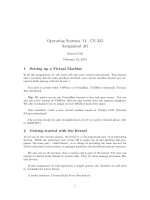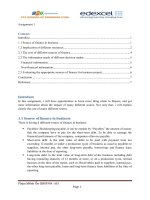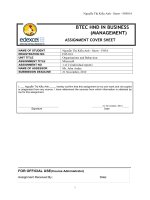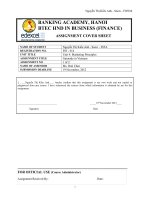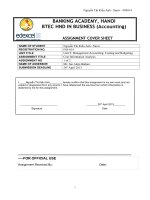1620 assignment 1 (pass)
Bạn đang xem bản rút gọn của tài liệu. Xem và tải ngay bản đầy đủ của tài liệu tại đây (1.36 MB, 21 trang )
Higher Nationals in Computing
ASSIGNMENT1
Learner’s name:: Đào Vĩnh Khang
ID: GCS200222
Class:GCS0905B
Subject code: 1620
Assessorname: VANHO
Assignmentdue:
Assignmentsubmitted:
ASSIGNMENT 1 BRIEF
Qualification
BTEC Level 5 HND Diploma in Computing
Unit number
Unit 3: Professional Practice
Assignment title
Planning an SDP Event
Academic Year
2022
Unit Tutor
Ho Hai Van
Issue date
7th January 2022
IV name and date
Dr. Doan Trung Tung
Submission date
Submission format
Part 1: Requirements
The submission should be made in the form of a completed individual portfolio folder, which
includes all the tasks outlined in the Assignment Brief. Although this assignment requires
collaborative work, each student must submit an individual portfolio folder.
Part 1: Produce a five-day professional event schedule (using project management software) and
WBS (work breakdown structure) prior to the five-day development event that details planning
and resource allocation including the (Responsibility Assignment Matrix)
Part 2: Create a ten-minute PowerPoint presentation on 'team dynamics' that includes a
presentation and an activity sheet that requires delegates to participate in a team-building activity.
(Maximum of eight slides, including the introductory slide)
Part 3: A written evaluation of your performance in this task and your contribution to the team.
You are required to make use of headings, paragraphs, subsections, and illustrations as
appropriate, and all work must be supported with research and referenced using the Harvard
referencing system. The recommended word limit is 500–1,000 words, although you will not be
penalized for exceeding the total word limit.
Assignment Brief and Guidance
You have been tasked with the responsibility of overseeing the development of an e-commerce
solution for a Fortune 500 company. As a member of the development team, you will develop a
plan, basing on the SDP (software development plan) that will be distributed to internal employees
and stakeholders within the organization in which you work.
You will develop a professional plan for this upcoming project by simulating real-world events,
meeting locations, agendas, feasibility reports, and associated costs.
NOTE: “You do not carryout real meeting in the venue but must get actual quotes of prices and
facilities in real life.”
You are expected to conduct thorough research on venue costs, transportation costs (if the project
takes place outside of the city), and team member feeding and lodging.
Assuming you have an experienced team of designers and developers, the development process
is estimated to take no more than five days.
The following is a description of SDP.
The Software Development Plan (SDP) is a document that describes how a developer intends
to proceed with a software development effort. The SDP provides insight into and a tool for
monitoring software development processes to the acquirer. Additionally, it details the
procedures to be followed and the approach to be taken regarding each activity, organization,
and resource. The SDP's purpose is to communicate to team members and stakeholders how
a program's software will be developed and how a Program Manager will allocate direct
resources.
Working in small groups (3-4 per group):
Part 1. Produce a professional event schedule (using project management software) and WBS (work
breakdown structure) prior to the five-day development event that details planning and resource allocation
including the (Responsibility Assignment Matrix)
Part 2. Create a ten-minute PowerPoint presentation on 'team dynamics' that includes a
presentation and an activity sheet that requires delegates to participate in a team-building activity.
(Maximum of eight slides, including the introductory slide)
Working individually:
Part 3 Produce a written team evaluation of the effectiveness and application of interpersonal
skills during the design and delivery process. You should also include a self-evaluation of your
performance in this project and your contribution to the team you worked in. Explain what skills
and qualities you gained from this project and what values you added to your development plan.
Identify the problems and produce a report discussing problem-solving and its importance in
planning and running a development event. Your essay should include a discussion of various
problem-solving techniques and justify the solution methodologies used during your project. You
should also have a critique of the application of critical
Part 3: Learning outcomes: LO1, LO2
Assessment Criteria
Pass
Merit
Distinction
LO1: Demonstrate a range of interpersonal and transferable communication skills to a target audience
P1 Demonstrate the use of 3 different
M1 Design a professional
D1 Evaluate the effectiveness
communication style within your team.
schedule to support the
and application of interpersonal
Discuss the purpose of a Software
Development with its objectives.
planning of an event, to
skills during the design and
include contingencies and
delivery of a training event.
justifications of time
P2 Demonstrate that you have used
effective time management skills in
planning an event.
allocated.
LO2 Apply critical reasoning and thinking to a range of problem-solving scenarios
P3 Demonstrate the use of different
M2 Research the use of
problem-solving techniques in the
different problem-solving
design and delivery of an event.
techniques used in the
design and delivery of an
event.
P4 Demonstrate that critical reasoning
M3 Justify the use and
has been applied to a given solution.
application of a range of
solution methodologies.
D2 Critique the process of
applying critical reasoning to a
given task/activity or event.
TABLE CONTENCT
P1. Demonstrate the use of 3 different communication style within your team. Discuss the
purpose of a Software Development with its objectives………………………………………………………….1
1/ Communication…………………………………………………………………………………………………………………..1
2/ What does the use of these expressive resources bring about in conversations?..................2
P2. Demonstrate that you have used effective time management skills in planning an event….2
1/ Requirement Analysis………………………………………………………………………………………………………….3
2/ Defining……………………………………………………………………………………………………………………………….3
3/ Designing……………………………………………………………………………………………………………………………..4
4/ Implementation……………………………………………………………………………………………………………………4
5/ Testing………………………………………………………………………………………………………………………………….5
6/ Evolution……………………………………………………………………………………………………………………………….5
P3. Demonstrate the use of different problem-solving techniques in the design and delivery of
an event…………………………………………………………………………………………………………………………………….5
1/ Definition………………………………………………………………………………………………………………………………6
2/ Type of problem need to handle……………………………………………………………………………………………6
3/ Problems and solutions in the training software……………………………………………………………………7
P4. Demonstrate that critical reasoning has been applied to a given solution……………………………8
1/ definition……………………………………………………………………………………………………………………………….8
2/ What are the steps of critical thinking you need to know?........................................................9
Assignment
P1. Demonstrate the use of 3 different communication style
within your team. Discuss the purpose of a Software
Development with its objectives.
1 Communication
1.1 denifition
Communication is the ability to communicate, exchange information, listen, respond, behave,
etc. between speakers and listeners to achieve the purpose of communication. Many people
mistakenly believe that communication is just the process of listening and speaking, but
communication also includes a series of other actions such as expressing emotions, gestures,
etc. So, effective communication is one of the basic and most important skills for students and
workers today. Moreover, communicating in a subtle and skilful way is also likened to an art.
1.2 Communication types in group
1.2.1 Nonverbal communication
Nonverbal communication (NVC) is the transmission of messages or signals through a nonverbal
platform such as eye contact, facial expressions, gestures, posture, and body language. It includes
the use of social cues, kinesics, distance (proxemics) and physical environments/appearance,
voice (paralanguage), and touch (haptics). It can also include the use of time (chronemics) and
eye contact and the actions of looking while talking and listening, frequency of glances, patterns
of fixation, pupil dilation, and blink rate.
Gestures made by hands, arms or body, and include head, face and eye movements, such as
winking, nodding or rolling eyes. Although research on rhyming gestures is sketchy, several major
groups of gestures have been identified by researchers. The most common gestures are called
logo gestures and quotation gestures. These gestures are customary, culturally specific gestures
that can be substituted for language, for example waving is used in Western culture to indicate
"hello" or "goodbye". separate". Each symbolic gesture can carry very different meanings in
different cultural contexts, ranging from praise to extreme annoyance. There are some global
gestures such as shrugging.
Facial expressions, above all, serve as a de facto mode of communication. With multiple muscle
groups that precisely control the mouth, lips, eyes, nose, forehead and chin, the human face is
thought to be capable of expressing more than ten thousand different emotions. This flexibility
makes the nonverbal character of the face particularly effective and realistic, unless there is an
intentional manipulation. In addition, most of the following emotions, including joy, sadness,
anger, fear, surprise, annoyance, shame, pain, and pleasure, are universal.
1.2.2 Verbal communication
Verbal Communication: One way of communicating through words (language) or sounds is verbal
communication. The simplest way to express thoughts, ideas, and feelings is to talk. Therefore,
it is the simplest and most effective. The sharing of information between individuals using
speech. Individuals working within a business need to use effective verbal communication that
uses words that are intelligible to say, as well as to ensure that the pronunciation, tension and
tone of the voice in which the words are written are express is appropriate.
Verbal communication is the use of words to share information with other people. It can
therefore include both spoken and written communication. However, many people use the term
to describe only spoken communication. The verbal element of communication is all about the
words that you choose, and how they are heard and interpreted
2 What does the use of these expressive resources bring about in
conversations?
Although most people can use communication styles, we can distinguish between individuals
according to the degree to which they tend to accept more often than one of them.
For example, in situations of conflict of interest, some people will tend to quickly adopt an
active communication style, or a passive one, and so on.
Also, on the other hand, although an assertive style is generally most appropriate, there are
specific situations in which a passive or aggressive style can make sense. For example, by
acknowledging a serious mistake you made yourself, or expressing frustration in a situation that
was someone else's fault. Rationality does not always precede our relevancy; In fact, it usually
has little effect on her.
P2.
Demonstrate that you have used effective time
management skills in planning an event.
We plan to design a software to manage and advise the health of the elderly. We will do it
through the following steps:
1 Requirement Analysis
1.1 denifition.
The first phase of SDLC is about deciding what you are going to develop. It can be said that this
stage is the most important of the whole SDLC process. If you're developing for a client, this
phase will likely include meetings to discuss their needs, goals, and expectations. If you're
developing a piece of software in-house, that might include market or competitor analysis,
customer interviews, and testing your company's goals. At a high level, you need to know what
problems you are trying to solve and how to solve them.
1.2 Results of the Requirement Analysis phase.
The result of this phase is the software requirements specification document, which serves as
the starting point for the next stage of development. It is important to note that the
requirements specification and analysis phase focuses only on what the software system should
do, not how it should be done. Like, we're working on older people's health so we should just
look for things that are related to that.
2 Defining
2.1 definition
Usually, you do the planning process after the requirements analysis after you've got all the
data and chosen what to develop. In this second SDLC phase we need to define several factors:
•
•
•
•
•
•
Who will lead the project?
Expected output or implementation
Number of developers needed for the project
How long will the project take?
Budget needed for the project
Any other project-specific considerations
2.2 Outcomes of the planning phase:
The outputs of the planning phase include project plan, detailed implementation timeline, cost
estimate and procurement requirements. Documents in this phase typically include:
•
•
Project Management Plan
Project Charter (charter) document
3 Designing
3.1 definition
The third phase of SDLC focuses on designing the software you will develop, including:
•
•
Architecture: What programming language do you use to build your product? What is
the industry best practices that you're building on? Also includes questions regarding
the use of templates.
User Interface: How do you expect potential users to interact with the product? How
would you make that easier for them?
•
•
•
•
Platform: What platform will your product run on? During this stage, a game developer
will wonder which console they will publish, while a mobile developer will decide if they
will create apps for Apple, Android, or both.
Programming: You've found a programming language, but now how do you overcome
the programming challenges of development?
Links: What content will your product have to communicate with? A central server?
Other applications? How will this happen?
Security: How will you protect your product against potential threats? Are you subject
to certain security requirements? Do you gain access to sensitive user information that
needs to be protected?
3.2 Outcomes of the design phase:
At the end of this phase, the Software Design Document (SDD) is completed. SDD will be
reviewed by all stakeholders and based on various parameters such as risk assessment,
software permanence, design modules, budget and time constraints time, the best design
method is chosen for the product…
4 Implementation
4.1 definition
The Implementation phase is the stage where developers code and build the application
according to the design documents and outlined specifications, using the chosen programming
language and framework. Developers will follow all the company's coding guidelines and use
various tools such as compilers, debuggers, and interpreters. Tasks are divided into units or
modules and allocated to specific developers.
4.2 Result of the development phase
During this phase, the development team will develop software based on the prototype. During
this phase, the software becomes a reality and is in beta for people to try and give feedback.
For example, someone who is using our software has encountered an error such as a frozen
screen, unable to download the application, not displaying disease information, ... We will rely
on users' opinions and fix the problems. error they encountered. Once done, the development
team will send the project to the testing team in the next phase.
5 Testing
5.1 definition
Once the code is complete, testing begins, and the modules are evaluated and tested to avoid
any errors. The built software is thoroughly reviewed during this process and any problems
found are assigned to the developers to fix or change.
Retesting and regression testing are conducted until the software is as planned by the user.
Testers often refer to SRS documentation to ensure software conforms to customer standards
or requirements.
5.2 Results of the testing phase
This stage is very important because when we hand over the test software to the customer. We
expect the software to work properly and that the functions do not conflict with each other
causing the application to crash.
6 Evolution
6.1 definition
After deploying a product to production, product maintenance begins. During this phase any
issues that emerge that need to be fixed or any improvements that need to be made will be
evaluated and implemented. In some cases, the SDLC process can be repeated from the ground
up (new functionality development, major software changes….)
6.2 Outcomes of the maintenance phase
This phase has 2 parts:
- Software repair: Perform correction of errors arising during the
use of the customer's software.
- Software update (update maintenance):
- Complete maintenance: Modify the software according to the customer's wishes
- Adaptive maintenance: Modifying software to adapt to new environments
7 Examples of time management skills
Our team consists of me, Dat, Phat, Khang and together they make software on health advice
for the elderly. We make that plan for half a year, we have given a demo for users to experience
and give feedback during use so that we can fix bugs so that everyone has a better experience.
One user commented that they were having trouble logging in to the software. Dat and I
discussed and tested the system together. We thank that customer and fix all errors in the
system up to the product launch date.
8 Example
I'm usually a very good time manager myself, I'm confident about it because:
- After being assigned an assignment, even though the deadline for submission is more than 1
week after being assigned, I break the assignment down into each day and arrange it in parallel
with the study time, this helps me not to feel stressed when assigned. exercise
P3. Demonstrate the use of different problem-solving
techniques in the design and delivery of an event.
1 Definition
Problem solving in psychology refers to the process of finding solutions to problems
encountered in life. Solutions to these problems are often specific to situations or contexts. The
process begins with problem finding and problem profiling, where the problem is discovered
and simplified.
2 Type of problem need to handle
Six-step problem-solving model:
•
•
•
•
•
•
define the problem
determine the root cause
develop alternative solutions – select a solution
implement the solution
evaluate the outcome.
This technique is applied not only for participants, but it is applied to our team
3 Problems and solutions in the training software
-
-
-
-
The number of attendees was not up to the original plan (less or more): we have a
method that confirms the number of members that are sure to join and reserve space
by enrolling via email.
If the rain is too heavy, we must cancel the team building and do some indoor activities
instead.
In case of force majeure, if the Invited faculty don't come on time, we will invite another
for the workshop. We will invite "Ly Thuy Hang" The Head of Student Affairs at the
University of Greenwich needs poetry.
When the occurrence program took place, the equipment could be damaged: it is
necessary to check carefully and have backup equipment to prevent bad situations from
happening.
Conflict in the group: we recognize that in a group with few members if conflict
happens, the group can be disbanded. Therefore, we try not to conflict, or if conflict
happens, we must solve the conflict carefully and completely.
P4. Demonstrate that critical reasoning has been applied to
a given solution.
1 definition
One of the most important aspects of academic work is the ability to think critically about what
you read, what you write, and what you are told. Rather than accept all information as truth,
you need to test the validity of others’ standpoints in order to arrive at your own point of view.
When you think critically, you are being active, you are not passively accepting everything you
read and hear, but questioning, evaluating, making judgments, finding connections, and
categorizing. Critical thinking is necessary in order to form judgments in lectures and tutorials,
when reading and when writing assignments
“A statement by Tara DE Lecce, Critical thinking is a term that we hear a lot, but many people
don't really stop to think about what it means or how to use it. This lesson will tell you exactly
what it means and make you realize that the average person largely ignores critical thinking.”
2 What are the steps of critical thinking you need to know?
We can achieve critical thinking with the help of six steps. They are as follows:
•
Knowledge
For each problem, a clear vision puts us on the right path to solve it and it recognizes
the argument that needs to be solved. In my case, there is an actual problem, need to
move forward with the critical thinking model. In this stage, I am discussing the problem
using critical thinking and exploring the main reasons like what is the problem? And why
do I need to solve it?
•
•
•
•
•
Comprehension
In the event, I identified the problem and try to understand the situation after that tried
to comprehend the reason my target audience was having less intense or feeling bored.
Application
In this step, I analyzed to take care of the issue of delivering the event. I utilized a mind
map during the training to analyze the situation, core problem and determine the best
way to move forward.
Analyze
During the training event, I collected once the information and built a linkage to analyze
in order to identify the situation, the strong points, the weak points, and the challenges
faced while solving the problem.
Synthesis
In this second last stage, I analyzed the problem fully and decided about how to solve
the problem and act. In that situation, I had chosen the problem solution is the SWOT
analysis that tends to identify the solution’s strengths, weaknesses, opportunities, and
threats.
Take action
In the final step, I built an evaluation about the problem that I put into action, and the
result of critical thinking easily transferred into action steps. I should not skip steps and
do as I planned to ensure the result is excellent.
REFERENCED
1. Communication: Luhrmann, Nicklas. "What is
communication?" Communication theory 2.3 (1992): 251-259.
/>(21/2/2002)
2. Verbal Communication: Jakobson, Roman. "Verbal communication." Scientific
American 227.3 (1972): 72-81.
(21/2/2002)
3. Non-verbal Communication: Phusela, Deepika. "The importance of non-verbal
communication." IUP Journal of Soft Skills 9.4 (2015): 43.
(21/2/2002)
4. Requirement Analysis: Georgy, Manju, and Andre Dharani. "A scrutiny of the
software requirement engineering process." Procedia Technology 25 (2016): 405410.
(21/2/2002)
5. Defining: Lin, Paul, Alexander MacArthur, and John Leaney. "Defining
autonomic computing: a software engineering perspective." 2005 Australian
Software Engineering Conference. IEEE, 2005.
(21/2/2002)
6. Designing: Moody, Daniel L. "The" physics" of notations: a scientific approach
to designing visual notations in software engineering." 2010 ACM/IEEE 32nd
International Conference on Software Engineering. Vol. 2. IEEE, 2010.
(21/2/2002)
7. Implementation: Brugger, Bernd, and Allen H. Dutoit. "Object–oriented
software engineering. using Ulm, patterns, and java." Learning 5.6 (2009): 7.
(21/2/2002)
8. Testing: Kuhn, D. Richard, and Vadim Okun. "Pseudo-exhaustive testing for
software." 2006 30th Annual IEEE/NASA Software Engineering Workshop. IEEE,
2006.
/>an (21/2/2002)
9/ Evolution: Mens, Tom. "Introduction and roadmap: History and challenges of software
evolution." Software evolution. Springer, Berlin, Heidelberg, 2008. 1-11.
(21/2/2002)
10/ Problem solving: Mayer, Richard E., and Merlin C. Wittrock. "Problem solving." Handbook of
educational psychology 2 (2006): 287-303.
(21/2/2002)
11/ critical thinking: Richmond, Barry. "Systems thinking critical thinking skills for the 1990s and
beyond." System dynamics review 9.2 (1993): 113-133.
(21/2/2002)



